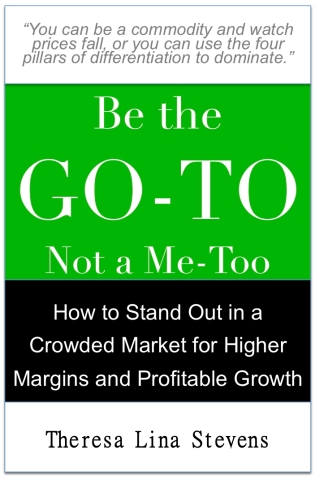I’ve written the introduction to my book and wonder if some of you could read it (see below) and let me know whether it makes you want to read the book. Please also share why or why not (assuming the topic is applicable to you, of course). Would love your feedback in the comments section. Thanks!
 How In the World Is That Person Making $30,000 a Day?
How In the World Is That Person Making $30,000 a Day?
This is the question that started it all.
About six years into my consulting business, one of my colleagues told me about her close friend who had less hands-on client experience than either of us and was commanding $30,000 a day to provide expertise to top executives. The consultant’s name was Martha Rogers of Peppers and Rogers, the firm famous for One-to-One Marketing, which revolutionized direct marketing and spawned digital marketing. I was at once terribly envious and incredibly inspired. (You’ll hear Martha explain it later in the book.)
This conversation occurred while I was in the midst of a reevaluation of my firm’s strategy, because we, on the other hand, were being forced to lower our prices. Somewhere along the way, our consulting services had come to be viewed as commodities, even by loyal clients who knew our capabilities well, understood how deep our expertise was and had been engaging us for years. They were starting to put pressure on us to lower our fees and talk about replacing us with less expensive, less experienced consultants as though we were interchangeable parts. We were also getting pushed further down into the organization, with less and less influence.
Meanwhile, and quite ironically, we were finding it increasingly difficult to convince our clients that they didn’t look, sound or act any different from the competition; that it wasn’t clear as to who they were trying to serve; and that they didn’t have a clear message that resonated with prospects. Even software companies were beginning to face the same challenges, as competitors started matching them on functions, features and price.
These experiences were in stark contrast to my earlier experience in helping to launch and grow what was then called the Telecom Industry Group (TIG) at Accenture. Starting from ground zero and operating much like a venture-backed start-up, we had lots of market forces working against us and still managed organic growth to over $250 million in five years…in the midst of a recession. This despite the fact that, at the time, if you weren’t a telephone company, you had no credibility in that industry; no one knew who we were or what we did; there was no existing market for what we were selling; the industry was already dominated by a few gigantic, well-entrenched providers; and in many ways, we didn’t know what we were doing. Nonetheless, we managed huge and very profitable year-over-year revenue growth, became the dominant player in our target markets, and laid the groundwork for what is today a multi-billion dollar business unit.
What did Martha Rogers and TIG do right? What did my firm and most business services and software companies need to do to achieve this kind of sustainable differentiation in order to ensure ongoing margin and revenue growth? Somehow, certain companies were each succeeding at becoming the dominant Go-To player, actively sought out by customers and able to command huge prices relative to the competition, while everyone else languished as Me-Too providers competing on price. I became obsessed with figuring out the recipe, embarking on an intensive research and analysis effort.
One day, on a plane to Chicago to meet with clients, I sketched out a strategy for my company. With so many years of Accenture’s methodology and project management training ingrained in me, naturally it was a step-by-step framework in the form of a flow diagram. I looked at it for a few minutes and said to myself, “This is what all of our clients need to be doing! This is how companies dominate a market space and become the Go-To.” It was the basis for what has become known as the Apollo Method for Market Dominance.™
That was 1998. Since then I have been seeking out the method’s weaknesses. I’ve gone inside companies as a full-time strategy and marketing executive to find out what’s hard about implementing it in practice. I’ve looked for better alternatives. I’ve continued to research it. I’ve lived through the “dot-com bust” of the 1990s and the Great Recession circa 2008-11. And I’ve watched hundreds of companies go out of business, because they didn’t implement one or more of the key elements.
Through all this, it became clear that the approach works, especially now that enterprise customers are starting to demand solutions to their problems and not just generic products or services, a key underpinning of the Apollo Method.
My research and experiences have resulted in some fascinating stories, examples and analogies, which I share in this book. You will learn market dominance strategy and marketing lessons from the Apollo Space Program, which declared its “Moonshot” goal and set out to dominate outer space against all odds. You’ll learn how to build momentum in the market place around your point of view and solutions the way successful companies have done it; the way campaigns build awareness and support for their candidates; the way Al Gore raised awareness of Global Warming; and the way rock bands build a following. You’ll also learn why clients with specific problems will be just as likely to seek you out over me-too alternatives as heart patients are to seek out cardiac surgeons over general practitioners. You will read inspirational stories about how companies like Google, Oracle, Cisco, and many others each became the Go-To in a relatively specific area of focus and then built from there. And you will find out about spectacular failures and lessons learned, including some of my own.
Who This Book Is For
This book is for you if your company operates in a highly competitive market full of me-toos. It’s for you, if your company is having trouble differentiating from the competition and is competing on price. It’s especially for you, if your company sells some kind of intangible product or service to businesses – the kind of product or service that is difficult for customers to hold in their hands, evaluate or compare to others until they have bought and are using it. This includes IT services and technology service providers, software and software-as-a-service (cloud) companies, some product companies, computing and telecommunications providers, management consulting firms and other service providers. It also includes industries with similar business fundamentals and competitive challenges include architecture and engineering, law, environmental consulting, and other professional and business services. Regardless of the sector, you will find that many, if not all, of these principles apply and can improve your margins and prospects for growth.
What role do you play in your company? This book is for you if your work has a direct or indirect bearing on revenue and/or margins. This includes direct or support roles in business unit operations and management; sales, business development, and partner relationships; marketing; product, service, and/or solution development and maintenance; client delivery and support activity; human resources and training; infrastructure and information systems; and financial management.
What You’ll Get From This Book
One of my frustrations as a practitioner is that I’ve yet to find a book or even a piece of paper that lays out a step-by-step rationale and approach for executing a particular strategy or marketing program. I myself have written or created generic strategic planning and marketing methodologies, but they are templates – they don’t explain how to achieve a particular business outcome. There are plenty of methodologies for systems development, project management, process improvement, and even generic marketing plan development. But the weakness with most marketing plans is that there is a terrific analysis of the situation, the market, the competition, the strategy, etc. and then one big giant bucket of tactics you may as well call “Stuff.”
I’ve never found anything that tells you, step by step, how to win in your market. Neither have I seen anything that shows a methodology for deciding which strategy or marketing tactics to choose and how to best implement them. Shockingly, no leadership executive or board member I’ve ever worked with has asked for one. In presenting a plan, I’ve always expected questions like, “Of the thousands of options to choose from, how did you decide on those specific tactics? How do the pieces fit together and build on one another? How are these going to develop the market? How will they lead us to market dominance and attract clients? What’s the long-term roadmap – how do these build on each other over the next few years to build our brand and entrench us? How do these investments tie to business outcomes and how are you going to measure them?”
This book will give you answers. Chapter 1 talks about your commoditization challenge and why that is a serious a problem for your business. Chapter 2 makes the case for aiming to become the Go-To, as opposed to a Me-Too commodity competing on price and scratching for business. Chapters 3-7 take you through the Apollo Method for Market Dominance, step by step. In addition to a conceptual overview, you’ll get practical advice on how to execute key components. You’ll also see examples of how other companies have successfully implemented them. Chapter 8 gets you started by helping you develop a simple but profoundly powerful one-page plan to get you started. You’ll walk away with a game plan that you can start implementing immediately and refine as you go.
There is no reason why any business should have to languish as a thin-margin, Me-Too player when there is the option to become a Go-To. The key is figuring out how to deliver such superior business impact that your clients will not fixate on price but rather on the value you deliver. This book will show you how to do that.


 y becoming the ringleader, the primary thought leader, for related discussions and market activity.
y becoming the ringleader, the primary thought leader, for related discussions and market activity. They address Kaiser’s higher purpose. One print ad shows an image of a jump rope curled into the shape of a human brain, with the copy, “Exercise doesn’t just make you feel better, offering a good defense against depression and anxiety. It helps you stay more alert and focused. Something you can think clearly about as you knock out just one last set. To learn more go to kp.org/thrive.”
They address Kaiser’s higher purpose. One print ad shows an image of a jump rope curled into the shape of a human brain, with the copy, “Exercise doesn’t just make you feel better, offering a good defense against depression and anxiety. It helps you stay more alert and focused. Something you can think clearly about as you knock out just one last set. To learn more go to kp.org/thrive.”


 How In the World Is That Person Making $30,000 a Day?
How In the World Is That Person Making $30,000 a Day?